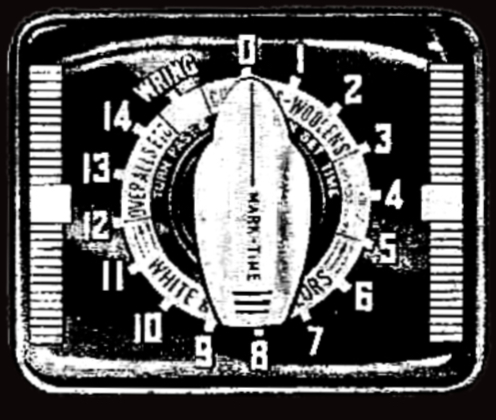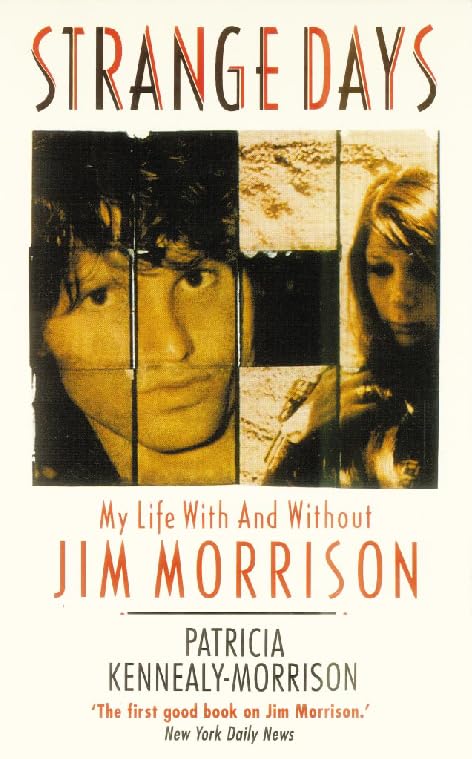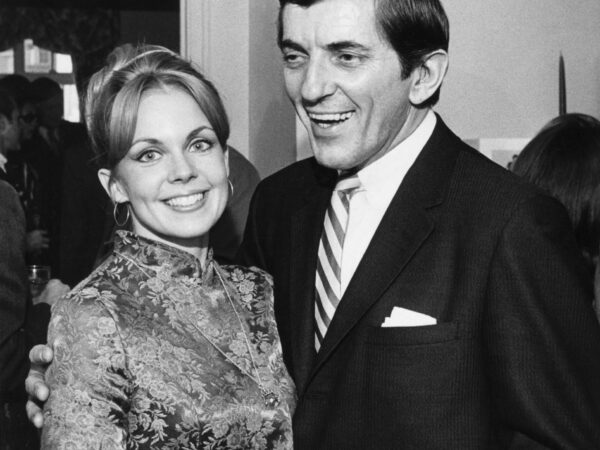Dutton/Penguin Group; May, 1992

“Jim Morrison Goes to the Renfaire!”
Strange Days is a roman à clef recounting Patricia Kennealy’s brief affair with Jim Morrison, the frontman of The Doors, which lasted five days or less starting in May 1970. Kennealy expands this short encounter into a years-long romantic narrative despite Morrison dying 11 months later.
In his “fat Elvis” years, the bloated, alcoholic Lizard King transforms into a perfect Irish prince, complete with a flounce shirt. Meanwhile, Kennealy portrays herself as a Mary Sue character. Patricia is the best writer, more intelligent than everyone else, more beautiful than any groupie, and triumphantly superior to that vacuous, small-breasted junkie Pamela Courson, Morrison’s long-term girlfriend. Patricia is a little full of herself.
Kennealy boldly asserts that she identifies as Irish—more Irish than a native-born Irishman—despite hailing from Long Island. Her accent isn’t NYC – New York Irish, she cries. She believes that she and Jim are soulmates destined to be together and hints they were an Irish couple in a past life or some such thing. Throughout the narrative, they drift through the waning days of the counterculture as if it were an extended Renaissance fair. Jim grins slyly, lounges, and writes poetry. Princess Pat dispenses Celtic wisdom, practices dagger play, performs witchcraft spells, and leaves a trail of shamrocks in her wake. There are great drugs. There is hot sex. There is trippiness. One can almost imagine all this activity happening against the backdrop of a psychedelic acid rock Liquid Lightshow with shamrocks and leprechauns popping up like toadstools.
Upon his return visit to New York, Jim’s love and devotion allegedly culminate in a handfasting ceremony in mid-June 1970. Though this is not a legal marriage, it is to Pat because Kennealy claims to be a witch. Patricia becomes pregnant, confronts Morrison, and later experiences a questionable late-term abortion in November. Jim is absent during this time because he is involved in a felony trial with the possibility of prison time in Florida. Dropping his drawers and exposing himself during a drunken concert in Miami in 1969 has unfortunate consequences.
According to Kennealy, she sees Jim one last time in early 1971 as he prepares to fly to Paris, leaving the U.S. to live with the flat-chested Pamela Courson forever and ever. In a tearful farewell, Jim confesses that Patricia is his one true love, and of course, he plans to leave Pam as he departs for France. Tragically, he dies in a bathtub in July. Denied a rightful place at his side in life, Patricia proclaims herself his widow in death.
Did I mention she identifies as Irish?
Strange Days is written in an annoying, florid fantasy style. This grandiloquence can bog down the narrative, making the prose turgid in places. At other times, what should be a recounting of events takes on the fevered pitch of a sweaty sword-and-sorcery bodice ripper. The author’s continual passive-aggressive jabs at the long-dead Pamela Courson are as irritating as nails on a chalkboard. Courson’s only sin is being the woman Jim loves. I could understand Kennealy’s bitter jealousy if she were still 21; however, she was in her forties when she wrote this book, so her continual sour grapes come off as a petulant, childish temper tantrum.
Sorry. Ms. Kennealy’s story is simply unbelievable. Over the years, her tale morphed from a chance encounter with Morrison when she was on assignment as a rock journalist to a strange, long-term love affair. This recounting is reminiscent of a fisherman’s story, where a minnow grows into a whale. Judging by the timeline, she and Morrison were together for five days or less during a stopover in New York City. Yes, she interviewed him for Jazz and Pop Magazine in 1969 and corresponded with him while reviewing the band’s new recordings and writing several articles. However, business correspondence usually doesn’t count as an affair.
That is the problem with the whole story. Kennealy provides no proof of their grand romance besides a handwritten handfasting document that suspiciously looks like someone wrote around Morrison’s autograph. The names of the other parties involved in the ceremony are conveniently redacted. She claims to possess an enormous collection of Jim’s writings, from poems to correspondence, yet no reproductions are offered as evidence. Kennealy explains this lack of proof by citing copyright laws. Such laws do not apply to envelopes and postmarks, though—so why weren’t those included?
Since starting this review, I discovered Ms. Kennealy died at age 75 in 2021. I felt compelled to say something positive about her work, even though the book as a whole is relatively poor. The dead can’t defend themselves. Thankfully, there are a few readable chapters.
The opening prologue is definitely worth reading. It recounts Keneally’s visit to Jim Morrison’s grave in Père Lachaise at the end of July 1971. While I do not want to minimize anyone’s grief, her account is so dramatic and exaggerated that some parts are unintentionally humorous. I can’t help but wonder how much of it is genuine and how much is fabricated. Here, she wanders the cemetery dressed in black with a long black veil. Trying not to be conspicuous, she stomps barefoot among the graves and discarded heroin needles until she finds Morrison’s final resting place. Once there, she throws herself prostrate over the grave and performs magic rituals. This chapter is attention-holding and showcases nearly cinema-quality dramatic writing.
I also enjoyed the chapter about Woodstock. Reading a behind-the-scenes perspective on such a historic music festival, especially where everyone enjoyed premium drugs, is always fascinating. Surrounded by the best rock music of the era, Kennealy shares her experience from the press box. As a bonus, she describes her voluptuous figure, her wardrobe for the event, and a peculiar moment when she sticks an antler-handled dagger in her waistband. I suppose carrying a dagger is normal for a massive hippie rock festival. Throughout the chapter, she expresses her frustrations with the love-and-peace vibe to the point where she admits it gets on her nerves until she wants to stab someone with her dagger. This candid peek into her mental state is intriguing if nothing else.
Chapter 28 is a must-read, even if you don’t focus on anything else. It details Kennealy’s involvement from late 1989 to early 1990 in Oliver Stone’s film The Doors. The writing is chatty, gossipy, and playful in parts. However, by the end of the chapter, Kennealy is angry at everyone except Kathleen Quinlan. I don’t understand why the author has so much animosity toward Oliver Stone. Yes, his film was not an accurate biography, but she acknowledges that Stone informed her of the fictional biopic elements from the beginning. She accepted a position as a technical advisor and even did a cameo. It seems that the fact she isn’t featured as Morrison’s only true love soured her perspective. Thanks to Stone, her fantasy affair has become part of pop culture rather than fading into obscurity. In the 21st century, many young bloggers mistakenly think she is Morrison’s widow. Mission accomplished, I guess! One should never bite the hand that feeds you, especially when you receive residuals and a chance to reshape the narrative of the Morrison myth. Yet, she looks this gift horse in the mouth.
I rate this book two stars. Yes, it has entertaining parts; it’s a trippy story from the 60s, and I feel a bit sorry for her. Patricia Kennealy ended her days as the Miss Havisham of the Lower East Side, pining for decades over a brief fling with a deceased rock star. This narrative may serve as a cautionary tale about the idolization of celebrities and the fans who take their infatuations too far. Take it with a grain of salt; her story can be an amusing fairy tale on a slow afternoon. But, as a true story, it falls seriously short.




